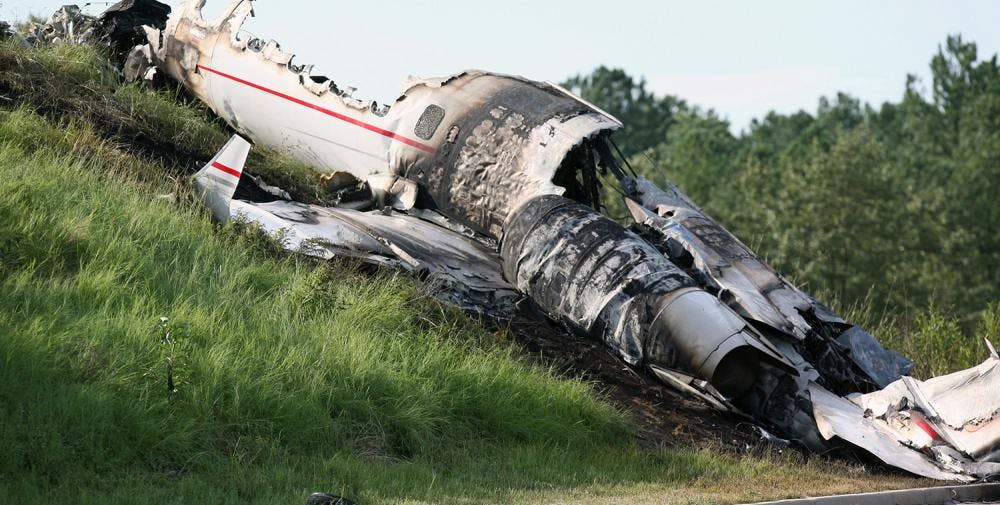Travis Barker’s Miracle Survival – The 2008 Learjet Crash
|
|
|
Joshua from Skyincidentmap.com
|
Travis Barker airplane accident: victims and survivors
On September 19, 2008, a horrific plane crash nearly took the life of famous drummer Travis Barker of the rock band Blink-182. Barker and his friend DJ AM were two of only two survivors from the devastating accident.
The pair had just performed a show in Columbia, South Carolina and were departing aboard a Learjet 60 private charter flight heading back to Los Angeles. Shortly after takeoff from Columbia Metropolitan Airport, the pilots reported a missed approach and attempted to return to the runway.
Witnesses watched in horror as the sleek Learjet struggled to gain altitude before banking sharply and slamming into a nearby residential area nose-first. The impact obliterated the jet and sparked an intense fire that rapidly engulfed the wreckage.
|
Learjet 60 wreckage after deadly accident |
Miraculously, Travis Barker and DJ AM somehow survived the initial impact, despite suffering severe burns. The two scrambled free of the flaming debris, with Barker’s clothing actually on fire before he was able to smother the flames.
|
Travis Barker and DJ AM survived the accident initially |
Tragically, the two pilots and two other passengers were killed in the crash. Two people inside a home that was destroyed by the crashing jet also perished in the disaster.
|
Sara Lemmon, a captain had 3,100 hours of flight time but only 35 of them were with Learjet 60 |
Both Barker and DJ AM were rushed to a burn center in critical condition. Barker had sustained third-degree burns over 65% of his body and spent multiple months undergoing over 25 surgeries and intense physical therapy during his excruciating recovery.
The cause
The harrowing ordeal and amazing survival of the two musicians garnered worldwide media attention. An investigation by the National Transportation Safety Board ultimately determined the probable cause was due to pilot error and the flight crew’s failure to follow proper procedures after aborting their initial takeoff.
Here are the key findings from the NTSB regarding the causes:
- The pilots failed to achieve the proper airspeed and improperly configured the plane after aborting the takeoff, leading to an aerodynamic stall at low altitude.
- The flight crew did not follow the approved procedure of raising the gear when executing a missed approach after takeoff, which further increased drag and made it harder to recover from the stall.
- The pilots did not follow the established stall recovery procedures and checklists, preventing them from regaining control of the aircraft.
- Lack of proper training by the aircraft manufacturer on stall recovery techniques in the Learjet model was also cited as a contributing factor.
Essentially, a series of procedural lapses and failures by the flight crew to follow established protocols after deciding to abort the takeoff put the plane in an extreme stall condition that it could not recover from at such a low altitude.
The NTSB determined that if the pilots had followed all checklists, configured the aircraft properly, and initiated the correct stall recovery procedures, the crash likely would have been averted.
|
NTSB report for Learjet 60 accident in 2008 |
For Travis Barker, the near-death experience and challenging recovery was a life-changing trauma. He openly discussed developing a fear of flying and leaving the hospital temporarily confined to a wheelchair and walker.
|
Travis Barker suffered from a fear of flying for a long time |
However, his profound gratitude at a second chance motivated him to eventually overcome his injuries through grit and determination. Barker returned to touring by 2011 and has worked to raise funds for burn treatment facilities.
|
Travis Barker visited burn center in Georgia |
The 2008 Learjet accident was a devastating tragedy, but Travis Barker’s incredible survival has become an enduring story of perseverance, the will to live, and not taking a second chance for granted.

